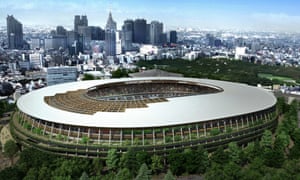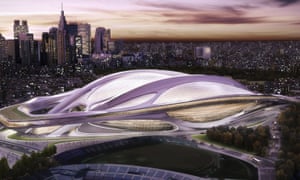
Japan has chosen a scaled-down design for the main stadium for the 2020 Tokyo Olympics, five months after scrapping the initial design and construction plan for being too costly.
The new model, by Japanese architect Kengo Kuma, will still cost 153bn yen (£825m) to design, build and maintain. The initial stadium proposal would have cost 252bn yen, making it the most expensive stadium ever built.
Kuma’s combined steel and wood structure, with a relatively flat roof and shrubbery along its outer concourses, echoes traditional temple designs. It stands 50 metres (164ft) tall, with the track and field below ground level.
“This is a wonderful plan which meets the basic vision in the new construction plan and requirements for construction period and the budget,” said the prime minister, Shinzo Abe, announcing the choice.
Tuesday’s announcement was a major step for organisers, who were forced to start again on a new design less than five years before the 2020 Games. The scrapping of the initial stadium plan forced the 2019 Rugby World Cup to change venues, and the late change had raised concerns about whether it could even be completed in time for the Olympics.
Organisers also had to deal with a plagiarism scandal over the logo for the event, and an investigation last month found backroom dealings in the selection process.
The chief cabinet secretary, Yoshihide Suga, told reporters that the design selection process was more transparent than the one for the previous stadium plan, and also addressed the main problems: cost and post-Olympic use.
The winning project will be led by major construction company Taisei Corp. Kuma, known for his Japanese aesthetic, also designed Tokyo’s Kabuki theatre, which was renewed in 2013.
Officials said the design won by a small margin over the alternative plan led by architect Toyo Ito and three construction companies, Takenaka, Shimizu and Obayashi.

Suga said Kuma’s plan was superior because of its ample environmental consideration and the capacity to be built quicker. The original plan by the British-Iraqi architect Zaha Hadid was criticised for its massive cost and scale.
Hadid said Japan’s scrapping of her plan was “shocking” and was not about design or budget. “In fact much of our two years of detailed design work and the cost savings we recommended have been validated by the remarkable similarities of our original detailed stadium layout and our seating bowl configuration with those of the design announced today,” she said.
[Source:- the gurdian]
